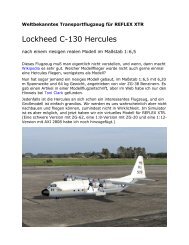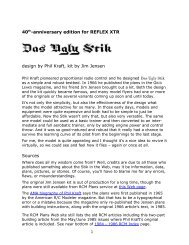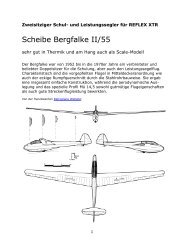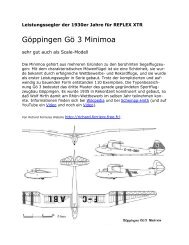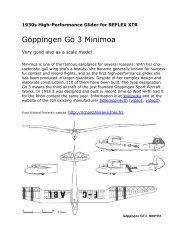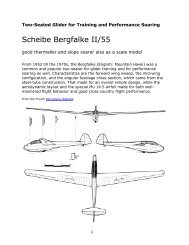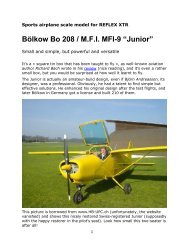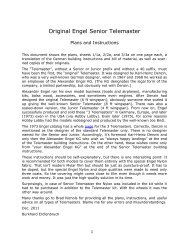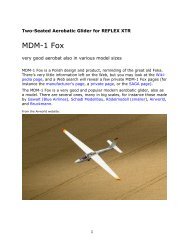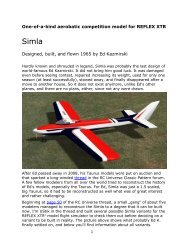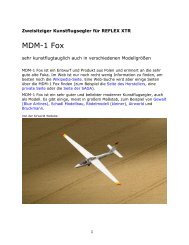Kwik-Fli Mark III for Reflex XTR
Kwik-Fli Mark III for Reflex XTR
Kwik-Fli Mark III for Reflex XTR
Create successful ePaper yourself
Turn your PDF publications into a flip-book with our unique Google optimized e-Paper software.
40 th -anniversary edition <strong>for</strong> REFLEX <strong>XTR</strong><strong>Kwik</strong>-<strong>Fli</strong> <strong>Mark</strong> <strong>III</strong>world champion pattern model by Phil KraftIn 1967, Phil Kraft was FAI pattern world champion flying his own design<strong>Kwik</strong>-<strong>Fli</strong> Mk <strong>III</strong>. Even though there were more elegant models, especially thisone became famous, probably just <strong>for</strong> winning the world championship, andwas built and enjoyed by many modelers all over the world.1Here is Phil Kraftshowing the originalworld championship<strong>Kwik</strong>-<strong>Fli</strong> and - evenmore in the <strong>for</strong>eground- his owndesignand -makeradio. He pioneeredproportional radiocontrol and exploitedthe potential of thisnew technology withhis own modeldesigns. The <strong>Kwik</strong>-<strong>Fli</strong>has to be the endpoint of that stage inthe evolution of R/Cmodel flying when<strong>for</strong> the first time theequipment allowedfull and real controlof the model. Itseems typical <strong>for</strong>Phil Kraft that hefound the simplestand most efficientdesign to reach thegoal.Next to Phil Kraft may beBill Northrop, back thenM.A.N.'s R/C editor.
40 th -anniversary edition <strong>for</strong> REFLEX <strong>XTR</strong> <strong>Kwik</strong>-<strong>Fli</strong> Mk <strong>III</strong>The <strong>Mark</strong> <strong>III</strong> was even quite elegant compared to the two earlier versions.These had a square horizontal tail with an undivided elevator. Thus, thevertical fin and rudder were quite small. Besides, the tail moment arm wasquite short and the thrust line rather high. These things might be leftoverfrom older design practice when only primitive R/C equipment was availableand pattern ability was limited.Anyway, Phil Kraft lowered the engine, elongated the tail moment arm bytwo inches, divided the elevator, and stretched the rudder down to the fuselagebottom. That made <strong>for</strong> some expense but it was worth it because patternability was noticeably enhanced. Both horizontal and vertical tail weredistinctively tapered. This embellishment was at nearly no cost because thetail feathers are flat so their outline may be arbitrary.On the other hand, the wing was built-up from ribs and spars and was mosteasily built square. Though sheeted foam core wings were already known inthe 1960s they were still quite unusual. It would have been easy to build atapered foam wing, but this might have been noticeably heavier than thebuilt-up wing, especially due to the thick airfoil used <strong>for</strong> the <strong>Kwik</strong>-<strong>Fli</strong>. Butmaybe as well Phil Kraft simply disliked foam wings.Obviously, he never found it worth the ef<strong>for</strong>t to build a tapered wing. Eventhough a <strong>Mark</strong> IV existed having one, he preferred the <strong>Mark</strong> <strong>III</strong>. Maybe hedidn’t need the small advantage of a tapered wing either because he was abrilliant pilot. But he used “barn-door” ailerons and not the easier-to-buildstrip ailerons. This may be again due to the thick airfoil because strips mightbe heavier, but again we don’t really know.Despite all his efficiency, Phil Kraft still cared much <strong>for</strong> good looks of hismodels if it was efficient and didn’t affect usability. So he simply rounded thewing tips and the tail feather tips, which were nicely painted. The fuselagetop was rounded but not the virtually invisible bottom. There was a nicecanopy yet an ugly hatch in front of it because easy access to the tank andfuel lines was so important.Net result was an attractive model that was able to fly the same patterns asthe full-scale planes. It did it to perfection, at least in the hands of a goodpilot. This required the new proportional R/C technology and some matchingairframe design features. <strong>Kwik</strong>-<strong>Fli</strong> Mk <strong>III</strong> was an excellent and economicalcombination of all this, proven by placing first at national and internationalchampionships. It deservedly became famous, even if it’s time was over verysoon when technology advanced and pattern competition became moreacrobatic and “ballistic”.For me, having the model in the simulator is reliving some of my youth whenI just couldn’t af<strong>for</strong>d it. But the model is the prototype of a low-wing sportmodel even today – simple, easily built, good-looking, good pattern ability,honest flyer. It’s just the most basic design of a pattern model. So it’s amodern model as well and worth to be flown at least in the simulator.2
40 th -anniversary edition <strong>for</strong> REFLEX <strong>XTR</strong> <strong>Kwik</strong>-<strong>Fli</strong> Mk <strong>III</strong>SourcesCredits are due to all those who published something about the <strong>Kwik</strong>-<strong>Fli</strong> inthe Web, may it be in<strong>for</strong>mation, data, plans, pictures, or stories. Of course,you’ll have to blame me <strong>for</strong> any errors, flaws, or misunderstandings.The AMA biography of Phil Kraft says the <strong>Kwik</strong>-<strong>Fli</strong> Mk <strong>III</strong> article was publishedin 1965 by the Model Airplane News magazine. This must be a typographicalerror or a mistake because the article is listed in the correct chronologicalorder and the magazine cover shown above is from February 1968. See theAMA biography.The 1968 publication is confirmed in the Vintage R/C Society’s airplanes list.There is a discussion about history of “Classic Pattern” at RC Universewhere especially post #20 describes the evolution of pattern designs.The kits by Jensen, Top <strong>Fli</strong>te, and Graupner are out of production <strong>for</strong> a longtime, though the plans are still available from Model Airplane News magazine(under AirAgeStore.com – Plans - RC Planes – Sport - Page 3).There was a reproduction of the original <strong>Kwik</strong>-<strong>Fli</strong> Mk <strong>III</strong> available as short orfull kit by Classic RC Hobby in the USA, and here’s a discussion with the kitmanufacturer. One of their customers has a build page.A build thread concerning the Classic RC Hobby kit in the “Classic Pattern”<strong>for</strong>um at RC Universe has also general in<strong>for</strong>mation about <strong>Kwik</strong>-<strong>Fli</strong>.Howard Engineering produced a modified <strong>Kwik</strong> <strong>Fli</strong> <strong>III</strong>. It featured taperedfoam wing, fiberglass fuselage, some other modifications, and retracts.There’s a very in<strong>for</strong>mative build thread in the “Classic Pattern” <strong>for</strong>um at RCUniverse, containing much general in<strong>for</strong>mation about <strong>Kwik</strong>-<strong>Fli</strong> (and the MANmagazine cover shown above).In the “Classic Pattern” <strong>for</strong>um at RC Universe was a comparison of the “Top<strong>Fli</strong>te <strong>Kwik</strong> <strong>Fli</strong> vs Graupner <strong>Kwik</strong> <strong>Fli</strong>”.Recently, Graupner brought out a <strong>Kwik</strong> Fly Mk3 (as they spell it) again, butas an “enhanced” ARF. In the “Classic Pattern” <strong>for</strong>um at RC Universe arecomments on it.In the “Vintage & Antique RC” <strong>for</strong>um at RC Universe was a comparison of the“Top <strong>Fli</strong>te Taurus or Graupner <strong>Kwik</strong> <strong>Fli</strong>” with a characterization of the <strong>Kwik</strong>-<strong>Fli</strong>in post #7.People may think differently about “Uncle Willie” and his website. But undoubtedlyone of his merits is to have presented images of original plans athis now extinct Web sites, even though I had found the <strong>Kwik</strong>-<strong>Fli</strong> plan only inone of his eBay offerings. Anyway, it was of paramount importance as itmade it possible to render the model in REFLEX in the first place.Take a look at Vintage R/C Society’s pages about Pattern Sequences andManeuver Descriptions to find a typical pattern program <strong>for</strong> the <strong>Kwik</strong>-<strong>Fli</strong>.3
40 th -anniversary edition <strong>for</strong> REFLEX <strong>XTR</strong> <strong>Kwik</strong>-<strong>Fli</strong> Mk <strong>III</strong>Eric D. Wildermuth from Brisbane, Australia, kindly provided scanned imagesof an article about <strong>Kwik</strong>-<strong>Fli</strong> <strong>Mark</strong> II in the 1965 RC MODELER magazine, of a<strong>Mark</strong> <strong>III</strong> plan in the May 1968 Aeromodeller magazine, as well as a shortdescription of the <strong>Mark</strong> IV from another magazine. Thank you very much!There’s a nostalgia website showing several old Graupner models includingthe <strong>Kwik</strong> Fly Mk3. The site is in German language but anyway you will findthe pictures most interesting, especially the construction pictures. There areeven a three-view drawing and an exploded drawing.The RCM magazine website still has several old articles <strong>for</strong> download. Therewas a series of articles on “Precision Pattern Design” by Ben Herman andJack Capehart where <strong>Kwik</strong>-<strong>Fli</strong> <strong>Mark</strong> II is explicitly mentioned several times.Modifications suggested there were applied to it giving the <strong>Mark</strong> <strong>III</strong>, thoughprobably independent from these articles. Long winded but good read, see atbottom of Requested Features page.The Radio Control Hall of Fame has several pictures of Phil Kraft and hismodels, especially several photos shot in Corsica during the 1967 FAI WorldChampionship. Well worth a look!ContributionsThese contributions were involuntarily, I simply borrowed some hard-to-getcomponents of the REFLEX model from other authors. At least they should begiven credit here:There was an Enya .60 engine on the original <strong>Kwik</strong>-<strong>Fli</strong> Mk <strong>III</strong>, but there is nosuch engine model <strong>for</strong> REFLEX. Bo (Jörgen) Strömberg from Sweden made aVeco engine <strong>for</strong> his excellent Graupner Taxi <strong>for</strong> REFLEX <strong>XTR</strong>. He published iton RC-Sim (see here) in August 2005 and later granted permission to usethe engine model. Thank you very much! The engine is enlarged a bit tomimic a .60 on the <strong>Kwik</strong>-<strong>Fli</strong>.The propeller is a wooden Master Airscrew that fits the old model. Prop sizein the visual model is 11” diameter and 7” pitch. The texture was borrowedfrom one of the many Internet shops.The wheel textures are borrowed from REFLEX.The engine sounds were borrowed from Thomas Hanser (see his models onhttp://www.rc-sim.com/) who published them with his Westerly and Extramodels on RC-Sim. I don’t know whether he recorded the sounds and fromwhat models, and I think he will not mind that they’re used <strong>for</strong> the <strong>Kwik</strong>-<strong>Fli</strong>.The idle sounds are the same, only the full power sounds are different, thelouder one used <strong>for</strong> the original version and the quieter one <strong>for</strong> the modelwith a muffler.4
40 th -anniversary edition <strong>for</strong> REFLEX <strong>XTR</strong> <strong>Kwik</strong>-<strong>Fli</strong> Mk <strong>III</strong>Shape and AppearanceSince I intended to revive the original in the first place I bought the old planfrom the well-known German publisher vth. Un<strong>for</strong>tunately, the plan showsmainly the <strong>Mark</strong> I and II. The <strong>Mark</strong> <strong>III</strong> version is only additionally drawn withdashed lines and the wingspan seems too big. An Internet search gave anexplicit <strong>Mark</strong> <strong>III</strong> plan in an eBay offer of Uncle Willie’s.It’s so small that it’s just sufficient <strong>for</strong> modeling in the REFLEX model builderprogram RMK, but it seems trustworthy because it confirms some dimensiondata. For instance, if the wing chord is assumed as 11” (Phil Kraft obviouslyloved nice round numbers) the wingspan comes to 60” what should becorrect. Anyway, the REFLEX model is now built using a plan and side viewmade from this plan. The correct dimensions were later taken from the planM.A.N. 76A scanned by Eric Wildermuth from a magazine and shown threepages below.The shape of a model in REFLEX is made of polygons. Much polygons andwork were spent on the ribs-and-spar structure of the wing. Viewing fromcertain angles, you’ll see the wing covering denting between the ribs andsheeting. You’ll have to keep some viewing distance, or the wing will look abit angular and awkward.Adequate to this viewing distance, details were applied to the raw body ofthe model. These are control horns and linkages, mounting dowels andrubber bands <strong>for</strong> wing and nose hatch, the main landing gear locks, and theantenna. The landing gear is fully detailed and working like the real one.The paint scheme was made as close as possible to the original one. The onlysource was the magazine cover shown above. Later someone presented twopictures from the October 1968 issue of Model Airplane News magazine onRC Universe. They show the original <strong>Mark</strong> <strong>III</strong> compared to the Flea <strong>Fli</strong>, a .20-sized version of the <strong>Kwik</strong>-<strong>Fli</strong>. Now the geometry of the paint scheme is quiteclear. The FAI stickers are still on wing and fuselage.5
40 th -anniversary edition <strong>for</strong> REFLEX <strong>XTR</strong> <strong>Kwik</strong>-<strong>Fli</strong> Mk <strong>III</strong>Still there’s nothing known about the model’s bottom and little about thecolors (see this post on RC Universe). But I think the REFLEX model’s overalllook is very similar to that of the original.6
40 th -anniversary edition <strong>for</strong> REFLEX <strong>XTR</strong> <strong>Kwik</strong>-<strong>Fli</strong> Mk <strong>III</strong>SetupThe old proportional radios were no computer radios and had neither exponor aileron differential. Things today being a radio setting were in the olddays possible only by properly arranging the control linkages of the model.Phil Kraft produced and used servos with linear actuators (not the rotaryhorns of today’s servos). Of course, the control horns are rotating around thecontrol axis. Thus, linkage geometry makes <strong>for</strong> some expo effect. The rotarycontrol deflection increases progressively faster from neutral to end than thelinear servo movement. In REFLEX, this is imitated by a – guessed – exposetting.In the wing, only one servo was used and linked to the ailerons by spanwisepushrods, 90-degrees horns and pushrods back to the control horns. Thesewere not perpendicular to the pushrod. Instead, the linkage point on thecontrol horn was a bit behind the aileron axis. That gave a nonlinear differential,which is approximated in REFLEX by an estimated 10% linear setting.The control deflections are chosen differently. The article accompanying theGerman plan mentions a certain aileron deflection to be correct and sufficient.The deflection given in millimeters converts to about 11 degrees.Assuming 10% differential, that makes <strong>for</strong> 11 degrees up and 10 degreesdown deflection. That is really sufficient <strong>for</strong> this kind of model (<strong>for</strong> three rollsin five seconds), even though it may not meet everybody's expectations.7
40 th -anniversary edition <strong>for</strong> REFLEX <strong>XTR</strong> <strong>Kwik</strong>-<strong>Fli</strong> Mk <strong>III</strong>8
40 th -anniversary edition <strong>for</strong> REFLEX <strong>XTR</strong> <strong>Kwik</strong>-<strong>Fli</strong> Mk <strong>III</strong>There were no recommendations <strong>for</strong> rudder and elevator, but rudder deflectionis limited to 30 degrees by the cutout of the elevator. So I simply setboth rudder and elevator deflections to this value what as well seemed to beadequate. You’ll need all rudder effect you can get, and 30 degrees elevatorreliably enable spins and snaps to be done. But after knowing data extractedfrom the Graupner plans (RC Universe post) and comparing the control hornpushrod positions in the original plan, I reduced elevator to 25 degrees.Phil Kraft took special measures to avoid any play in the control linkages.Though I only know of special bearings <strong>for</strong> the aileron bellcranks, I set zeroplay <strong>for</strong> all controls. 1% play showed little but still noticeable swaying.The model’s weight is simply set to 6 lb following a recommendation in oneof the web pages on the <strong>Kwik</strong>-<strong>Fli</strong>. The article accompanying the German planeven says the model should be extremely lightweight. The web page saysmaximum should be 6.5 lb.The drive settings are based on power and torque measurements publishedin an older German book. It seemed suitable to assume a .60 OS engine andan 11x7" propeller. Following a strong recommendation in the article accompanyingthe German plan, no engine down thrust and right thrust were set.There is a recommendation <strong>for</strong> some decalage, though. The wing’s leadingedge should be 1.5 to 2 mm higher than the trailing edge what converts to0.3 to 0.4 degrees positive angle-of-incidence. This compensates <strong>for</strong> a smallpart <strong>for</strong> the landing gear’s drag and <strong>for</strong> the most part <strong>for</strong> a quite <strong>for</strong>wardposition of the center-of-gravity (C/G). The RC MODELER article even says3/32" what converts to 0.5 degrees. So it was set to this value what givesneutral trim upright but requires down elevator inverted.The C/G is set as shown in the plan, what means 4" / 102 mm behind thewing's leading edge. Blaine Beron-Rawdon’s Plane Geometry spreadsheetscompute 13.5% static margin what is quite big <strong>for</strong> a pattern competitionmodel. By the way, static margin is the distance between C/G and neutralpoint compared to the wing chord. The model would behave nicely also with5% or even less, but the big static margin means much stability.To compare a less stable, crisper flight behavior, an alternative setup with3.5% static margin and only 0.16 degrees decalage was added. It is nearlyneutral both in upright flight and inverted. It might need down elevator whentaxiing, but such a trim “on the main wheels” seems to be not uncommon.We don’t know which setup Phil Kraft used <strong>for</strong> the world championship. It’spossible that he liked the neutral behavior and recommended the stable setupas more suitable to pilots less talented than him. But it’s as well possiblethat he used the stable setup because it desensitized the model to servo inaccuracies(as this post on RC Universe suggests). Anyway, the stable, <strong>for</strong>wardC/G setup is now the “<strong>Mark</strong> <strong>III</strong> original” version in REFLEX while theneutral setup is the “<strong>Mark</strong> <strong>III</strong> crisp” version.9
40 th -anniversary edition <strong>for</strong> REFLEX <strong>XTR</strong> <strong>Kwik</strong>-<strong>Fli</strong> Mk <strong>III</strong>10
40 th -anniversary edition <strong>for</strong> REFLEX <strong>XTR</strong> <strong>Kwik</strong>-<strong>Fli</strong> Mk <strong>III</strong><strong>Fli</strong>ght BehaviorAs usual, I took the geometry from the plan and put it into Blaine Beron-Rawdon’s excellent Plane Geometry spreadsheets (see his website) to getmost of the physical parameters. The airfoil and wing coefficients werecalculated in an own spreadsheet. All calculated values and the C/G positionfrom the plan were simply transferred to REFLEX – and the model workedright away. This is another case where no tweaking or fudging was needed.Some plausible assumptions had to be made <strong>for</strong> the airfoil. The one shown inthe plan has approximately 18% thickness but is not a NACA 0018, whichhas a rather blunt leading edge. The most similar airfoil <strong>for</strong> which I haveGerman low-Re measurements is Eppler E 169. Its thickness is only 14.4%but I projected the coefficients <strong>for</strong> analogy.Ignore the nice guy on the picture; pay attention to the wing’s leading edge.It seems to be especially sharpened, most likely <strong>for</strong> better spin and flick per<strong>for</strong>mance.It might just be a reflex but at least it's not a standard NACA 0019noted <strong>for</strong> its blunt leading edge. The plan above shows a noticeably sharperleading edge and Phil Kraft himself mentions the “sharply radiused leadingedge” in his first <strong>Kwik</strong>-<strong>Fli</strong> article. Anyway, the E 169 airfoil used <strong>for</strong> the simulatormodel shows an adequate stall behavior.11
40 th -anniversary edition <strong>for</strong> REFLEX <strong>XTR</strong> <strong>Kwik</strong>-<strong>Fli</strong> Mk <strong>III</strong>The above-mentioned article says Phil Kraft had a second model with thinnerairfoil (the Bar-<strong>Fli</strong>, see below), which he had used if there had been morewind during the world championship. <strong>Kwik</strong>-<strong>Fli</strong> Mk <strong>III</strong> is a light-wind, lightweightmodel that flies patterns at moderate speed. It is built to be lightweightand not to be slick and have low drag. Nevertheless, it already givesan idea of the later development to “ballistic” pattern flying.The wing’s aspect ratio is rather small (5.3), thus wing area rather big andwing loading low. This makes <strong>for</strong> good slow-flight capabilities, particularlybecause induced drag will be high at slow speed – no flaps needed, neitheras lift enhancers nor as brakes. Induced angle-of-attack (AOA) is big, makingthe model quite insensitive to pitch changes.Due to the square plan<strong>for</strong>m, no tip stall and no inadvertent stall at all willoccur. On the other hand, the airfoil justifies a reasonable stall setting in theairfoil parameters. The model will spin using the classical competition entryinto spin. It will even snap when full rudder and a bit aileron in the samedirection are used, of course in addition to full elevator.Due to the small deflections and maybe the small differential of the ailerons,there’s virtually no adverse yaw. The model is smooth on aileron and doesn’tyaw in rolls. Though the vertical stab is rather high above the longitudinalaxis, there’s surprisingly little yaw-to-roll coupling. In knife-edge flight, onlya bit top aileron and up elevator are needed. There’s also much directionalstability and smoothness, presumably due to the long tail moment arm andthe 2 degrees dihedral. It’s just a joy to fly classic aerobatics with this plane.This behavior is what I would expect of a model having <strong>Kwik</strong>-<strong>Fli</strong>’s geometry.REFLEX is amazing because it credibly renders all this flight behavior. I think<strong>Kwik</strong>-<strong>Fli</strong> is just the type of model REFLEX was initially made <strong>for</strong> – more than15 years ago. And that’s why I think this rendering is quite realistic – thoughI don’t know <strong>for</strong> sure, of course.12
40 th -anniversary edition <strong>for</strong> REFLEX <strong>XTR</strong> <strong>Kwik</strong>-<strong>Fli</strong> Mk <strong>III</strong>Tapered WingPhil Kraft himself tried outtapered-wing versions of the<strong>Kwik</strong>-<strong>Fli</strong>, actually called the<strong>Mark</strong> IV. But he didn’t find itworth the ef<strong>for</strong>t to build it andjust didn’t like it, so he stuckto the square-wing <strong>Mark</strong> <strong>III</strong>.But others found it easy tobuild a tapered wing frombalsa sheeted foam cores andpreferred the better snapabilityof the <strong>Mark</strong> IV. Afterall, more snap (flick) maneuverswere added to the competitionaerobatic schedule.The <strong>Mark</strong> IV was simply a <strong>Mark</strong> <strong>III</strong> with a different wing. On the other hand,this wing was a simple variant of the square wing. Just this modification andreplacement has been duplicated in REFLEX with another paint scheme traditionallyused <strong>for</strong> the <strong>Kwik</strong>-<strong>Fli</strong> (see picture above).13
40 th -anniversary edition <strong>for</strong> REFLEX <strong>XTR</strong> <strong>Kwik</strong>-<strong>Fli</strong> Mk <strong>III</strong>As usual and as <strong>for</strong> the basic design (see plan 5 pages above), Phil Kraftchose nice round numbers: 12" root chord and 9" tip chord giving a 0.75taper ratio. The airfoil was modified as well by slimming a 20% thick root toa 15% thick tip. The 60" wingspan exclusive wingtips gave almost as muchwing area as the 58x11" square wing. The ailerons got smaller, though, andrequire a bit more deflection.Some dihedral is gotten by leaving 1" room under each wing tip at the 30"half-span point. This converts to 1 degree dihedral what gives 2 degrees atthe wing bottom and a straight wing top. This layout was typical <strong>for</strong> most ofthe tapered-wing pattern designs coming later. On the other hand, the 1"-room-under-the-wingtips recommendation applied also to the <strong>Mark</strong> <strong>III</strong> andalready to the <strong>Mark</strong> II. In these cases, 1" at the 29" half-span point convertsto 2 degrees dihedral. There’s no difference in directional stability, though,maybe because the only 1 degree dihedral of the <strong>Mark</strong> IV is complementedby 1 degree sweep of the wing (2.4 degrees at the leading edge).The only real change in flight behavior is better flick per<strong>for</strong>mance, thoughreally better only with the “crisp” balance. Whereas <strong>Mark</strong> <strong>III</strong> is hard to flickespecially to the right, <strong>Mark</strong> IV flicks easily at nearly any flight speed usingonly elevator and rudder (the old-school method). It may even flick withelevator only, but one has to really snap it to full deflection to accomplishthat. Thus the model is still not vicious and is actually the better version.Obviously, Phil Kraft didn’t think so. As reported in this post on RC Universe,he tried even two variants, this one and another one with 15% constantairfoil thickness (both called the <strong>Mark</strong> IV). This one was the best, but bothvariants had less drag than the <strong>Mark</strong> <strong>III</strong> and there<strong>for</strong>e were not as constantspeedin patterns. Besides, Phil Kraft found them touchy around neutral onthe ailerons. It’s clear that he disliked both peculiarities because he wasknown <strong>for</strong> his smooth and elegant flying style.The <strong>Mark</strong> IV REFLEX model has less roll moment-of-inertia and roll dampingand more aileron effect than the <strong>Mark</strong> <strong>III</strong> model. There’s little difference inflight behavior, at least in the simulator. But it is noticeable and may beenough to disappoint a choosy pilot.14
40 th -anniversary edition <strong>for</strong> REFLEX <strong>XTR</strong> <strong>Kwik</strong>-<strong>Fli</strong> Mk <strong>III</strong>EnhancementThe name <strong>Kwik</strong>-<strong>Fli</strong> doesn’t mean a fast flying airplane but a model that isquickly built and thus flying soon. As a matter of fact, <strong>Kwik</strong>-<strong>Fli</strong> is a slow flyingplane with it’s thick airfoil, boxy shape, and low weight. The simple designactually contributes to the low weight and thus the good flight characteristics.A fixed landing gear matches this design because it weighs notmuch and the drag doesn’t matter. Besides, it’s simple and robust.On the other hand, Phil Kraft produced retractable landing gears and evenused one <strong>for</strong> the <strong>Kwik</strong>-<strong>Fli</strong> <strong>Mark</strong> <strong>III</strong>, even though it may seem inappropriate.Pattern flying developed to heavier and faster models and he had to staycompetitive. In the late 1960s, more powerful .60 engines came out, whichwere bigger and heavier, though, and had a muffler which was required atcontests. Both engine and retracts made <strong>for</strong> some weight, but that was noweven welcome <strong>for</strong> the faster flying style since the models were smoother ingusty wind and did better spin and snap maneuvers.Phil Kraft experimented with new model designs, beginning 1969 with theSlik-<strong>Fli</strong>. It featured a tall fuselage like the Bar-<strong>Fli</strong> (see below), a swept wingwith straight trailing edge, and what is called snap-flap today. The next design,Dragon <strong>Fli</strong>, kept the tall fuselage but reverted to the unswept wing of<strong>Kwik</strong>-<strong>Fli</strong> Mk IV, and had retracts. Finally, the Fire-<strong>Fli</strong> reverted to a slenderand now rounded fuselage and was used at the 1971 world championship.15
40 th -anniversary edition <strong>for</strong> REFLEX <strong>XTR</strong> <strong>Kwik</strong>-<strong>Fli</strong> Mk <strong>III</strong>At least till then Phil Kraft obviously flew a <strong>Kwik</strong>-<strong>Fli</strong> Mk <strong>III</strong> at contests (e.g.here, even with wing fillets), just turned into an up-to-date pattern ship inhis typical, simplistic own way. The picture above (posted at RC Universe,source unknown now) shows him with a rather straight <strong>Mark</strong> <strong>III</strong>. The canopyhas been omitted, maybe to avoid the “<strong>Kwik</strong>-<strong>Fli</strong> dance” (see below) and/or tolower drag. The engine is a newer one with a flow-through muffler, and thereare retracts. Only the fuselage nose is obviously modified.There has been made room <strong>for</strong> the slightly longer engine, and the nose hadto be made taller to accommodate the nose landing gear. By making the bottomlower, a shorter landing gear leg could be used that fits in front of thewing when retracted. Still the nose wheel is so big that the tank had to beset higher, so the hatch runs now horizontally and not sloped like on a standardMk <strong>III</strong>. Supposedly, the model's weight is considerably higher, so even7 lbs are assumed <strong>for</strong> the REFLEX model. The engine is assumed to have(typically) 1.25 hp and spin a customary 11x7" propeller. That makes <strong>for</strong>decent flight speed but still gives a very good 0.87 thrust/weight ratio.It's really a different model now, but the typical <strong>Kwik</strong>-<strong>Fli</strong> smoothness isretained. It's just considerably more powerful, flies big round patterns, anddoes even reverse spins as well as old-school snap rolls (flown without ailerons),even though only to the left. It seems to be a typical <strong>Kwik</strong>-<strong>Fli</strong> assetthat snap rolls are “clean”, meaning they are easily and cosistently stoppedat the right point and end with the same attitude as they were begun with.With the higher wing loading, landings are not as easy as be<strong>for</strong>e but notreally hard, either. The “<strong>Mark</strong> <strong>III</strong> enhanced” version is balanced neutrally16
40 th -anniversary edition <strong>for</strong> REFLEX <strong>XTR</strong> <strong>Kwik</strong>-<strong>Fli</strong> Mk <strong>III</strong>because to me a stable balance would make little sense. It would detractfrom the spin and snap per<strong>for</strong>mance of this heavier square-wing version.To me it seems that Phil Kraft was just very fond of the <strong>Kwik</strong>-<strong>Fli</strong> wing design.In his articles about his newer designs he's lamenting about several drawbacksof tapered wings, especially swept ones, unprecise ailerons, and more.In the early 1970s, the new flying style required new designs, though. Maybeit was just his flying style which was no longer up to date.Retractable Landing GearIn the first place, I didn't believe that Phil Kraft used retracts on a <strong>Kwik</strong>-<strong>Fli</strong>,but I wondered what the newer, more powerful engines and retracts wouldmake out of the <strong>Kwik</strong>-<strong>Fli</strong> design. So I just tried it in the simulator <strong>for</strong> bothwing versions. That went to show that the “<strong>Mark</strong> <strong>III</strong> retracts” version is aquite different model, as is the “<strong>Mark</strong> IV retracts” version with tapered wing.The retract mechanism makes <strong>for</strong> some weight and delicacy. The landinggear is prone to damage so the model should be flown from paved runways.The increased weight gives higher landing speed and the retracts should givehigher flight speed. Un<strong>for</strong>tunately, the increase in flight speed is rather low.It’s anyway assumed that this is a 1970s version. There<strong>for</strong>e, a quite powerfulengine is spinning an 11x8" (higher-pitch) propeller. Overall weight is 6.5 lb,which is the recommended maximum. It’s supposed that the 1970s R/C gearwas lighter than the 1960s proportional gear, so that partly compensates theadditional weight of the retractable landing gear and the muffler.17
40 th -anniversary edition <strong>for</strong> REFLEX <strong>XTR</strong> <strong>Kwik</strong>-<strong>Fli</strong> Mk <strong>III</strong>The engine is side-mounted <strong>for</strong> better looks and to have the carburetor andthe tank level. It’s slanted 30 degrees upward, though, to have the exhaustand the muffler beside the fuselage. Matching the sleek look of the modelwith side-mounted engine and retracted landing gear, a different livery wasapplied. It’s still a paint scheme traditionally used <strong>for</strong> the <strong>Kwik</strong>-<strong>Fli</strong>, though,and I even stuck to the orange and dark blue colors. I only beveled the innerends of the stripes on wings and horizontal tail and put a big Roman 3 or 4on the vertical tail. All dowels and rubber bands were omitted because theywere replaced by snap-on mechanisms and bolts or CamLocks in the 1970s.The center-of-gravity was moved further backward to have only 2.0% staticmargin. Together with only 0.05 degrees decalage, this makes <strong>for</strong> a completelyneutral longitudinal balance meaning the model will fly where youpoint it. The main landing gear was moved backward a bit as well, so themodel will stay level on the ground but still take-off easily. That’s all quitethe same <strong>for</strong> the square wings and the tapered wings version.Even though there’s not really much changed in the “<strong>Mark</strong> <strong>III</strong> retracts” and“<strong>Mark</strong> IV retracts” versions compared to the “<strong>Mark</strong> <strong>III</strong> crisp”, these are justconsiderably more powerful, sleeker, and faster airplanes. You may knockthem around just <strong>for</strong> fun without risk because they are still not vicious. Butyou may just as well fly serious aerobatics, both upright and inverted, andeven do snap rolls the old-school method only with elevator and rudder andwithout ailerons (though ailerons still help especially with the square wings).This version already gives an idea of the even sleeker and faster patternships which came after the <strong>Kwik</strong>-<strong>Fli</strong>.18
40 th -anniversary edition <strong>for</strong> REFLEX <strong>XTR</strong> <strong>Kwik</strong>-<strong>Fli</strong> Mk <strong>III</strong>ProgressThe evolution of pattern model design was influenced by changing flyingstyle and vice versa. Both were driven by progress in technology. The newproportional R/C got better and better and, above all, had less weight. Theengines got more powerful at the same weight and even stayed as powerfulas be<strong>for</strong>e when mufflers were needed and added some weight. So competitionpattern style developed from constant low speed flying to constant highspeed flying and the patterns became big and round.The models had to be faster and more powerful than be<strong>for</strong>e, even at the costof considerably more weight. The airframe had to be sturdier what made <strong>for</strong>some added weight, and a retractable landing gear <strong>for</strong> low drag and highspeed as well contributed to the weight. The combination of high speed andhigh weight might explain the term “ballistic pattern”, but of course it meansmainly the fast and jet-like flying style.The <strong>Kwik</strong>-<strong>Fli</strong> was not at all a ballistic pattern ship but instead a sample of theolder constant low speed model. But quite small modifications would makesort of a “rocket” pattern ship of it, at least nearly. These modifications weredone to the REFLEX <strong>XTR</strong> model in two steps.The first step was to put a Graupner/O.S. 49-PI rotary engine on it, whichweighs only 395 g / 13.9 oz including muffler and mount. Of course, the<strong>Mark</strong> IV with retracts was chosen <strong>for</strong> it’s low drag. The engine is able to takeit to high speed because it may per<strong>for</strong>m up to 2 hp at up to 20000 rpm if ahot fuel is used. It’s low weight and small diameter are important as well. Formore in<strong>for</strong>mation about this engine see my article on Das Ugly Stik.19
40 th -anniversary edition <strong>for</strong> REFLEX <strong>XTR</strong> <strong>Kwik</strong>-<strong>Fli</strong> Mk <strong>III</strong>Using such a rotary engine in reality might be a real pain, and it wouldn’t lastlong operated at high power, but that’s both irrelevant in the simulator. Thereally used conventional .61 engines with tuned pipes were powerful but alsoquite heavy – too heavy <strong>for</strong> the <strong>Kwik</strong>-<strong>Fli</strong>. The rotary engine is just a simpleand adequate (and even realistic) solution.The engine fits well into the fuselage’s cross section. With a nicely roundedcowl the model’s drag is lower than be<strong>for</strong>e and engine cooling should still beenough. Now also wing fairings just had to be applied because the fuselagewingcrossing is definitely a source of strong turbulence. So all major dragsources, except the thick wing, are eliminated.The overall weight could be lower as well, but what the engine is lighter thana normal .61 is used to “beef up” the model. Otherwise, flick maneuvers athigh speed would damage it. Whereas the <strong>for</strong>mer versions are set up <strong>for</strong> a15 maximum-g factor, the new version needs 20 and thus has the sameweight as the previous ones.Despite the small low-pitch 9x6" propeller, the high engine rpm makes <strong>for</strong>high flight speed. Pattern flying already looks quite “ballistic” though it couldstill be faster. The thick wing airfoil prevents the model from being really“ballistic”, but at least it makes landings still quite practicable. This versionwas simply called “<strong>Mark</strong> IV rotary” in REFLEX <strong>XTR</strong>.So there’s one important modification left. The model has to be equippedwith a thinner wing. The plan<strong>for</strong>m was left unchanged but different airfoilswere assumed, instead of 20% to 15% from root to tip now 15% to 10%. Asan average, the 12.4% thick Eppler E 168 was used to choose realistic coefficients.Though this is still not really thin, it gives somewhat lower drag anda really “ballistic” model, now even called “<strong>Mark</strong> V rocket” in REFLEX <strong>XTR</strong>.20
40 th -anniversary edition <strong>for</strong> REFLEX <strong>XTR</strong> <strong>Kwik</strong>-<strong>Fli</strong> Mk <strong>III</strong>Now the model is already quite hard to land even on long runways. With theretractable landing gear, only paved runways are suitable. Though patterncompetition pilots could handle that, it was still important to make landingseasy. After all, take-off and landing belonged to the competition schedule.So models were equipped with speed brakes or flaps <strong>for</strong> glide angle controlto facilitate spot landings. Un<strong>for</strong>tunately, in the newer versions of REFLEX<strong>XTR</strong> the coefficients <strong>for</strong> flaps and ailerons are the same, so it’s not possibleto give them different characteristics. There<strong>for</strong>e, the “rocket” <strong>Kwik</strong>-<strong>Fli</strong> has nospoilers but normal flaps, which give lower approach speed due to more liftand a steeper approach due to much drag at 45 degrees deflection.Un<strong>for</strong>tunately, the flaps themselves and the servo and linkage make <strong>for</strong>some weight, so overall weight is now set to even 7 lb. But they are real“barn doors” and have a huge effect. You may fly small traffic patterns andsteep landing approaches and touch down “on the spot”. Landing is somethinglike with the original version, but the flaps make <strong>for</strong> a lower angle-ofattackwhat is quite pleasant. You don’t have to use the flaps, but they arethere just in case you would like to use them, and I think you will like them.This “rocket” version now really should be the final step in the modification ofthe <strong>Kwik</strong>-<strong>Fli</strong>. Later models had swept wings, real airfoils <strong>for</strong> the tail feathers,lower vertical tail, anhedral horizontal tail, and fuselages with large <strong>for</strong>wardside area <strong>for</strong> knife-edge flying. The next milestone in the evolution probablyis the Curare with which Hanno Prettner won the 1977 world championship.Both Hanno and the Curare became world-famous like Phil Kraft and the<strong>Kwik</strong>-<strong>Fli</strong>, so I should better build the Curare <strong>for</strong> REFLEX <strong>XTR</strong>. But this“rocket” <strong>Kwik</strong>-<strong>Fli</strong> version somewhat bridges the 10 years of developmentbetween both models.21
40 th -anniversary edition <strong>for</strong> REFLEX <strong>XTR</strong> <strong>Kwik</strong>-<strong>Fli</strong> Mk <strong>III</strong>By the way, I didn’t invent the paint scheme, I just borrowed it. It is quitecommon <strong>for</strong> the Zlin Z-526 AFS, which has similar lines. It fits the <strong>Kwik</strong>-<strong>Fli</strong>with only minor adjustments and looks pretty dynamic in blue and especiallyin red. The registrations are those of the two Cessna C206 Turbine I wasvery fond of 20 years ago. They just give me a warm memory.I called the tapered-wing variant with retracts and rotary engine the <strong>Mark</strong> IVand put a big “4” on it’s nose. That’s justified because Phil Kraft himselfdesigned and named it. But naming the thin-wing variant the <strong>Mark</strong> V andputting a “5” on it’s nose is completely unauthorized. What Phil Kraft wouldhave thought?TodayToday, a good sport model looks the same as in the 1970s, but it shouldhave an electric drive. That saves much trouble unavoidable when using glowengines. Powerful electric drives are still a bit heavy, and they give a reasonableflight time only due to their efficiency. Outrunner electric motors arespinning large propellers at low rpm, so thrust is big but at low flight speed.However, just that matches the original <strong>Kwik</strong>-<strong>Fli</strong> design.The model was an extreme lightweight to fly at slow speed. So some boxyshape and a tricycle landing gear didn’t hurt but on the contrary contributedto the low weight. Much drag was good <strong>for</strong> constant slow flight speed, whichis also why the wing airfoil was very thick (18%, or 20% to 15% tapered).22
40 th -anniversary edition <strong>for</strong> REFLEX <strong>XTR</strong> <strong>Kwik</strong>-<strong>Fli</strong> Mk <strong>III</strong>Even the tapered-wing <strong>Mark</strong> IV is not vicious, though it is not <strong>for</strong> the rankbeginner. But an owner and pilot of a low-wing sport model should be able tohandle it and would appreciate its flick per<strong>for</strong>mance, so it was made the“<strong>Mark</strong> IV electric” version in REFLEX <strong>XTR</strong>.The customary AXI 4120/14 brushless outrunner motor with a 6000 mAh5s2p LiPo battery spins a 12x8" APC Sport propeller, as recommended byModel Motors <strong>for</strong> aerobatic models. The overall weight of this drive should be1250 g / 44.1 oz. This is a bit more than the weight of an old .60 drive, butinstead the modern R/C components are lighter than the old ones. So theoverall weight of the model is assumed to be nearly the same as that of the“<strong>Mark</strong> IV original” version.Of course, low flight speed is still much more than parkflyer speed (in factfour times as much). But the model will gently and vividly go through anyclassic aerobatic maneuver. The 10 minutes flight time should be enough <strong>for</strong>a decent pattern sequence. This configuration is so good that it makes nosense to build a variant with thin wing, flaps, and retracts. <strong>Fli</strong>ght speedwould be only less than 10% higher but weight and trouble more than that.Again, the paint scheme is one used <strong>for</strong> the Zlin Z-526 AFS. And again, theregistration is one of those two Cessna C206 Turbine (after re-registration) Iflew 20 years ago. The model just needed an engine cowl, wing fairings, anda canopy rim <strong>for</strong> less drag and better looks.NostalgiaIt must have been a lucky chance <strong>for</strong> Graupner: a model that everybodywants to have because it was world champion, that is yet so well-behavedthat everybody is able to handle it, and that is even easy to build. Theyimmediately seized this opportunity and brought out their kit version as soonas to the Feb. 1968 Nuremberg toy fair (see their 75th anniversary website).Recently, Graupner re-released the <strong>Kwik</strong>-<strong>Fli</strong> Mk <strong>III</strong> (or KWIK FLY MK3 as theyspell it), but as an “enhanced” version with a modern engine, hidden in acowl, and a tall retractable landing gear <strong>for</strong> good ground clearance and lessdrag and clean look in the air. The paint scheme was somewhat modernized.I think the “old” <strong>Kwik</strong>-<strong>Fli</strong> fans won’t like this new version and would preferthe old one, brought out 1968. So do I, and so I made this “nostalgia” version<strong>for</strong> REFLEX <strong>XTR</strong> (I just had to). Someone presented the photo shownbelow on RC Universe (Web links see above). It shows the <strong>Kwik</strong>-<strong>Fli</strong> picturepage of a 1975 Graupner catalog with enough detail to copy the model.These are the pages we looked at over and over again when we were youngand couldn’t af<strong>for</strong>d the model and especially the proportional R/C equipment.Of course, these pages were well-thumbed and not those that showed thebeginner models <strong>for</strong> 4-channel reed equipment. Now <strong>for</strong> us a dream comestrue – virtually.23
40 th -anniversary edition <strong>for</strong> REFLEX <strong>XTR</strong> <strong>Kwik</strong>-<strong>Fli</strong> Mk <strong>III</strong>This is thepage from anold Graupnercatalog.And here is the REFLEX model:24
40 th -anniversary edition <strong>for</strong> REFLEX <strong>XTR</strong> <strong>Kwik</strong>-<strong>Fli</strong> Mk <strong>III</strong>Tell the difference! The (old) Graupner logo behind the spinner was intentionallyomitted because I couldn’t find a graphics file in the Web (and wastoo lazy to draw it) and because I think it’s ugly at least on the left fuselageside and I don’t like such advertising on models either. For quite a while, Iwondered what the symbol on the fin might be. Eventually, there was apicture in an eBay offer large enough to show it. Again, the Graupner logowas omitted.The engine is not the O.S. H60F-GP "Gold Head" as well brought out 1968.Both model and engine were boosted as top-notch until 1974 when the O.S.H60F-GR "Black Head" or the even more powerful 60F-SR replaced the GoldHead. I especially bought an old O.S. 60F-SR to render it in REFLEX. It got aGraupner 11x7" Super Nylon propeller on the <strong>Kwik</strong>-<strong>Fli</strong>. Un<strong>for</strong>tunately, I havenot the sound of this drive but only the one mentioned above.The model is so dressed up that I think Graupner had designers to find aneffective paint scheme. On the other hand, they took the liberty to improvethe kit compared to the original. I rendered the white wheel rims (dressedup) as well as the double-strutted nose landing gear (improved).<strong>Fli</strong>ght behavior of this “Graupner KWIK FLY MK3” version in REFLEX <strong>XTR</strong> issimply like the somewhat heavier but more powerful “<strong>Mark</strong> <strong>III</strong> retracts”version but with fixed landing gear and re-balanced <strong>for</strong> neutral flight. Thepropeller is a customary 11x7" and not an 11x8".Reduction25
40 th -anniversary edition <strong>for</strong> REFLEX <strong>XTR</strong> <strong>Kwik</strong>-<strong>Fli</strong> Mk <strong>III</strong>Phil Kraft proudly presented a scaled-down (0.66) version of the <strong>Mark</strong> <strong>III</strong> –the Flea <strong>Fli</strong> (see pictures on page 6 above). It’s quite close to the originaland has even the same wing loading. Engine is not a .40, though, but a .20which is not as powerful <strong>for</strong> the Flea as the .60 <strong>for</strong> the original but still quitesufficient <strong>for</strong> the 2.5 to 2.75 lb weight.The geometry is nearly exactly scaled down. The dowels and rubber bands<strong>for</strong> the wing were replaced by leading-edge dowels and trailing-edge bolts.The control horns <strong>for</strong> rudder and elevator are rather big to fit the still quitebig servos that Phil Kraft produced in the 1960s.The REFLEX model is painted like the model Phil Kraft shows on the picturesabove. These are borrowed from a thread on RC Universe as well as the planshown below (whole article in this build thread).The plan suggests .19 to .23 engines, and I assumed an O.S. MAX .19 justbecause I still own such an old mill. With an 8x6" propeller this would give arather small 0.55 thrust/weight ratio compared to 0.8 of <strong>Mark</strong> <strong>III</strong>. But theflight speed is only a bit lower and quite right <strong>for</strong> the Flea. It just takes sometime to reach full speed and you’ll need constant full power <strong>for</strong> aerobatics.Of course, the Flea seems to fly faster and swifter due to its smaller size (39"wingspan), but you will still notice the typical smooth flight characteristics.26
40 th -anniversary edition <strong>for</strong> REFLEX <strong>XTR</strong> <strong>Kwik</strong>-<strong>Fli</strong> Mk <strong>III</strong>HistoryOf course, the predecessors of the <strong>Mark</strong> <strong>III</strong> were<strong>Mark</strong> II and <strong>Mark</strong> I, but what’s the difference andwhat is better on <strong>Mark</strong> <strong>III</strong>? Let’s work back in theline of ancestors.This short <strong>Mark</strong> II article was in the April 1965issue of the RADIO CONTROL MODELER magazine,only a short while after the initial <strong>Kwik</strong>-<strong>Fli</strong> article inthe October 1964 RCM issue. The <strong>Mark</strong> II had alreadybeen mentioned in the first article but hadnot been flown much. <strong>Mark</strong> I was an initial designwith emphasis on quick building (hence the name<strong>Kwik</strong>-<strong>Fli</strong>) and it was quite big (66 x 12 in wing) <strong>for</strong>use with the then new .60 engines. <strong>Mark</strong> II got anembellished, tapered stabilizer while the <strong>Mark</strong> Istabilizer was square like the wing. But above all,<strong>Mark</strong> II was a slightly smaller version (60 x 11 inwing) <strong>for</strong> use with the more reliable .45 engines.<strong>Mark</strong> II is said to be a better contest machine dueto its smaller size and the same wing loading, butobviously not a .45 but a .60 engine soon gotstandard because stronger flies better (sort of).To match the smaller wing, the tail moment armwas shortened by 1.5 inches though it’s not toldbetween which reference points the moment armis measured. The horizontal stabilizer’s outline issimilar to that used later on the <strong>Mark</strong> <strong>III</strong>, but theelevator is still undivided and quite small. Like onthe <strong>Mark</strong> I, the fuselage bottom ends in a tip justbelow the elevator hinge line, and the vertical finsits a bit ahead of the stabilizer so the rudder iscompletely in front of the elevator hinge line andabove the fuselage. The rudder pushrod has to runabove the horizontal stab and maybe that’s why itwas the same on the <strong>Mark</strong> <strong>III</strong> in the first place andonly later moved below the horizontal stab.The wing was modified in a clever way. To reducethe span, one rib frame was left out on each wingtipso the landing gear and the inner aileron tipsstayed in place. The 18%-thickness airfoil wasscaled down to give one inch less chord length anda correspondingly shorter aileron chord. The referencepoint <strong>for</strong> scaling was at 25% chord length, so27
40 th -anniversary edition <strong>for</strong> REFLEX <strong>XTR</strong> <strong>Kwik</strong>-<strong>Fli</strong> Mk <strong>III</strong>the leading edge got 0.25” backward and the trailing edge 0.75” <strong>for</strong>ward.The center-of-gravity stayed at the same percentage of the chord length atthe main spar. Obviously, just shortening the tail moment arm by 1.5” andleaving the tail areas unchanged gave about the same tail effectiveness.These tail modifications were undone <strong>for</strong> the <strong>Mark</strong> <strong>III</strong>. Instead, the horizontaltail was nicely tapered and the elevator enlarged. This was easy or evennecessary because the elevator anyway had to be divided in two halves. Thevertical tail was set back to the same moment arm as the horizontal tail, andthe rudder was elongated quite a bit below the horizontal stab. Of course,the fuselage now ends in an edge and no longer in a tip. The fuselage’s rearend is no longer a triangle but now square which is supposed to make <strong>for</strong> astructural weakness. Anyway, the elevator is a more complicated build now.Originally, the engine was high on the fuselage nose. Maybe this was olddesign practice to counteract nose-up tendencies in powered flight. This andany decalage are not good <strong>for</strong> a pattern airplane, though. For <strong>Mark</strong> <strong>III</strong> theengine thrust line was lowered to be near the center of drag. Whereas theengine was <strong>for</strong>merly slanted about 30 degrees to get the carburetor spraybardown to the tank level, it is now mounted upright without causing problems.The hatch behind the engine is no longer level with the fuselage top but atan angle down to the spinner. But this makes the fuselage shape only slightlymore complicated.The <strong>Mark</strong> I article says the left model on the picture is the third prototype –all white with black trim. I think the paint scheme is a predecessor of the oneused <strong>for</strong> the world-championship <strong>Mark</strong> <strong>III</strong> and I used the customary orangeand dark blue instead of white and black. The model on the right has to be28
40 th -anniversary edition <strong>for</strong> REFLEX <strong>XTR</strong> <strong>Kwik</strong>-<strong>Fli</strong> Mk <strong>III</strong>the second prototype with straight wing (no dihedral) and without roundedwing and empennage tips. Anyway, it was disregarded.The <strong>Mark</strong> II pictures above already show the paint scheme that was usedlater <strong>for</strong> many <strong>Mark</strong> <strong>III</strong> copies, except the lightning bolts on fuselage andvertical tail. Obviously, Phil Kraft’s favorite colors were used but a clearcanopy. Maybe a blue tinted canopy was made only <strong>for</strong> important modelsused in competition.Comparing the <strong>Mark</strong> I and the <strong>Mark</strong> <strong>III</strong> plans it seems obvious that <strong>Mark</strong> <strong>III</strong>is essentially an enhanced <strong>Mark</strong> I. <strong>Mark</strong> II is an intermediate step or a sidestep with its smaller wing and tail moment arm. The rest is like <strong>Mark</strong> I, thehorizontal stab modification being only an embellishment. <strong>Mark</strong> <strong>III</strong> combinesthe smaller <strong>Mark</strong> II wing with a larger vertical tail at a longer moment arm(and a bigger elevator). Both vertical and horizontal tail are embellished atthe same time. The fuselage is modified only to fit the lower (and more <strong>for</strong>ward)engine and the bigger rudder while the fuselage length is unchanged.All <strong>Kwik</strong>-<strong>Fli</strong> versions have a low wing loading, but due to its size and thelower thrust/weight ratio <strong>Mark</strong> I flies peculiarly. It’s almost like a free-flightmodel that learnt to fly pattern, but in no way bad and actually quite good<strong>for</strong> the time. It was one of the first pattern models with a symmetric airfoilwhat avoids bothersome pitching moments. Due to the rather small tail areaand moment arm the model still won’t stall or even spin, at least in the simulator.But in the early 1960s flying patterns at all was the main progress andin a pinch spins were achieved by special means (rudder/elevator boost).29
40 th -anniversary edition <strong>for</strong> REFLEX <strong>XTR</strong> <strong>Kwik</strong>-<strong>Fli</strong> Mk <strong>III</strong>But soon this was taken <strong>for</strong> granted and <strong>Mark</strong> II with its smaller size and thesame wing loading was appreciated <strong>for</strong> better authority in gusty wind. Thebetter thrust/weight ratio obtained by using a .60 engine was appreciated aswell, especially <strong>for</strong> competition where patterns flown faster look nicer or areeasier to fly, respectively. Still <strong>Mark</strong> II doesn’t fly really neat patterns andwon’t reliably spin or snap, not even the “crisp” version.30
40 th -anniversary edition <strong>for</strong> REFLEX <strong>XTR</strong> <strong>Kwik</strong>-<strong>Fli</strong> Mk <strong>III</strong>No wonder, because according to the plan <strong>Mark</strong> I and II have 30 degreesrudder throw but on a short moment arm and only 20 degrees throw of therather small elevator.<strong>Mark</strong> <strong>III</strong> has the engine thrust line near the center of drag and the verticaltail’s aerodynamic center is much lower than be<strong>for</strong>e, both making <strong>for</strong> cleanerpatterns. The big fin and rudder and the bigger elevator, together with thelong tail moment arm not only help in yawing maneuvers (like stall turns)but also enable spins and snaps to be reliably done. (See Phil Kraft's Feb.1968 MAN <strong>Mark</strong> <strong>III</strong> article.)All three <strong>Kwik</strong>-<strong>Fli</strong> versions show the typical smooth flight behavior, so it mustbe mainly due to the wing design. The different characteristics may be seenas the steps from the <strong>for</strong>mer, nearly free-flight designs <strong>for</strong> reed R/C to thefully controlled designs <strong>for</strong> proportional R/C. As I said in the second paragraphabove…<strong>Mark</strong> I and <strong>Mark</strong> II are rendered in REFLEX with their original paint schemeand in Phil Kraft’s favorite orange and blue color. The flight behavior parametersare derived from the model’s geometry. Like any simulator, REFLEXis a simplification of a real airplane. But the differences between the <strong>Kwik</strong>-<strong>Fli</strong>versions are so fundamental that you’ll still notice the resulting differences inflight behavior even though they are rather small. It’s amazing that we havethe look and feel of the old models today, even if only virtually. By the way,<strong>Mark</strong> I and II are both balanced on the main spar, as given in the plan, in the“original” version and balanced neutral in the “crisp” version in REFLEX.AlternateOf course, the Bar-<strong>Fli</strong> isn't really a <strong>Kwik</strong>-<strong>Fli</strong>, but it is rather similar and it wasPhil Kraft's alternate model <strong>for</strong> the 1967 world championship. It has the FAIstickers on wing and fuselage on the front page picture of the 1968 RCM&Eissue. Our consideration would not be complete without comparing also thismodel to the <strong>Kwik</strong>-<strong>Fli</strong> Mk <strong>III</strong>, including the hands-on experience in the simulator.There is much in<strong>for</strong>mation given by Phil Kraft himself in the Aug 1968MAN article and the Dec 1968 RCM&E article, both with plan and available inthe Classic Pattern Image Base.Obviously, the model had been designed and built just <strong>for</strong> a change from the<strong>Kwik</strong>-<strong>Fli</strong> Mk II and just <strong>for</strong> sport flying. It was made a bit smaller (58 x 10 inwing instead of 60 x 11 in), got a thinner airfoil (15% instead of 18%) and adeep fuselage with much side area as well as a large rudder like that of the<strong>Kwik</strong>-<strong>Fli</strong> Mk <strong>III</strong>. Unexpectedly and despite being a bit small, it turned out tobe a very good pattern ship, especially in high winds and turbulence. So thereason why it was chosen as the secondary model <strong>for</strong> the world championshipwas only the mild weather <strong>for</strong>ecasted <strong>for</strong> Corsica. Being a bit smootherin such conditions due to slightly bigger size and thicker wing section, <strong>Kwik</strong>-<strong>Fli</strong> Mk <strong>III</strong> was preferred as the primary model. Actually, it was a tie.31
40 th -anniversary edition <strong>for</strong> REFLEX <strong>XTR</strong> <strong>Kwik</strong>-<strong>Fli</strong> Mk <strong>III</strong>There's nothing special about design and build of Bar-<strong>Fli</strong>, and all dimensionsare nice round numbers. The wingspan is 58 in including the two 1 in tips, sowing area is only 560 sqin. The all-up weight should come in at 5 to 5½ lb.The .60 engine is a bit slanted, to have the exhaust outboards and <strong>for</strong> betterlooks, and may get a 2½ in spinner. The paint scheme is nearly the same asthat of <strong>Kwik</strong>-<strong>Fli</strong> Mk II as to the outlines, except the stripes on the turtledeckand around fin and rudder. The colors are different, though, as the maincolor is a sober red and the stripes are black. The pinstripes are gold and thecanopy is the silver base coat. The name comes from the bar-like fuselage.As usual, the engine is mounted without any down or right thrust. The horizontalstabilizer is set to zero incidence while the wing should have 1/16 inpositive incidence what computes to 0.38 degrees. Dihedral should be 1 inunder each wing tip meaning 2 degrees. The balance point is drawn 3½ infrom the leading edge just on the rear side of the main spar. Phil Kraft triedmoving the C/G from this 35% position back to even 60% of the wing chordand found the model not very sensitive to C/G location. There are the “Bar-<strong>Fli</strong> original” and “Bar-<strong>Fli</strong> crisp” versions in REFLEX to compare.32
40 th -anniversary edition <strong>for</strong> REFLEX <strong>XTR</strong> <strong>Kwik</strong>-<strong>Fli</strong> Mk <strong>III</strong>The Bar-<strong>Fli</strong>'s overall layout is very similar to that of <strong>Kwik</strong>-<strong>Fli</strong> Mk <strong>III</strong>. The deepfuselage is advantageous <strong>for</strong> certain maneuvers while the thin wing sectionmakes <strong>for</strong> more speed in all maneuvers, particularly since Bar-<strong>Fli</strong> is lighterthan <strong>Kwik</strong>-<strong>Fli</strong> Mk <strong>III</strong> but has the same wing loading and the same powerful.60 engine. It seems that Phil Kraft found it a bit too small only in terms ofthe visual impression of the judges in competition.That is no wonder, however, since Bar-<strong>Fli</strong> is the faster and more powerfulmachine. Flying faster and bigger patterns, it has to be flown at greaterdistance to the judges what may have more effect than the only slightlysmaller size. And the higher speed is only partially due to the thinner wingairfoil. After all the overall smaller size reduces drag, and the lower weightincreases the thrust/weight ratio from 0.8 to 0.91, what is quite spectacular.Setting the parameters <strong>for</strong> REFLEX gave some insight into the subtle differencesbetween Bar-<strong>Fli</strong> and <strong>Kwik</strong>-<strong>Fli</strong> Mk <strong>III</strong>. The general layout is similar, andBar-<strong>Fli</strong> has only slightly more wing aspect ratio. The ailerons are a bit shorterbut that doesn't matter because they are more effective on the thinner airfoil.I chose the Eppler E 475 because it is a special 15% aerobatic airfoilwith a pronounced stall behavior, giving the good snapping ability describedin the articles. The good stall-turn ability is due to the huge vertical tail thatis even bigger than that of <strong>Kwik</strong>-<strong>Fli</strong> Mk <strong>III</strong> and even nearer to the centerline.33
40 th -anniversary edition <strong>for</strong> REFLEX <strong>XTR</strong> <strong>Kwik</strong>-<strong>Fli</strong> Mk <strong>III</strong>The slightly superior maneuverability is achieved by the same controlthrows: 30 degrees rudder, 25 elevator, 11 aileron. The big engine sits on ashort nose moment arm making <strong>for</strong> low pitching and yawing inertia.For the “Bar-<strong>Fli</strong> crisp” version, the balance point was set back by 1½ in toexactly 50% and the incidence angle reduced to 0.25 degrees. The mainlanding gear legs have to be bent backward to keep the nose wheel on theground. The airplane is now neutral both upright and inverted and morecom<strong>for</strong>table to fly. As Phil Kraft stated, there is a bit more elevator effect,but the most important effect seems to be much better snap/flick ability.That's the very good pattern machine described in the articles, maybe evenbetter than <strong>Kwik</strong>-<strong>Fli</strong> Mk <strong>III</strong> except lacking a small bit in size and smoothness.The simulator model has a Veco engine instead of the original's Enya 60 II,which was not available <strong>for</strong> modeling. The Enya is especially short so theVeco protrudes quite a bit, but that doesn't really matter.The red color may be not the original one, but it's impossible to learn it fromthe magazine cover picture above. At least it's consistent with a (color corrected)photo found in the Radio Control Hall of Fame (half page down) andit's quite nice. The RCM&E article just specifies “red and black color schemewith gold trim”. The cover picture is retouched and does not show the pinstripesaround the fuselage lightning bolt and around the vertical tail, either.So far, I couldn't identify the oval signet on the vertical tail so I left it out.34
40 th -anniversary edition <strong>for</strong> REFLEX <strong>XTR</strong> <strong>Kwik</strong>-<strong>Fli</strong> Mk <strong>III</strong>SceneryThere is a scenery on RC-Sim, very well suited to this model especially withretractable landing gear. Horst Lenkeit perfectly rendered one of the nicestmodel flying sites in Austria. It’s the field of the Klagenfurt model flying clubin St. Johann, the field where Hanno Prettner once practiced. There’s a longtarmac runway and much room.The scenery is just great, but it seems the digital camera failed finding asuitable white balance. At least the colors look quite cold. You might correctthat yourself in a graphics program like the GIMP. But since I did that andbesides removed a hump from the runway you may as well try my version.Try the different <strong>Kwik</strong>-<strong>Fli</strong> versions on the nice long tarmac runway and youwill see why there were those paved runways in the old times and why themodels even had wheel brakes. There’s no problem at all to land the slowflying<strong>Kwik</strong>-<strong>Fli</strong> on this runway, but even this lightweight model needs someroll distance to full stop. And the heavy “ballistic” ships with their high landingspeed might even use up the whole (148 m / 485 ft) runway.35
40 th -anniversary edition <strong>for</strong> REFLEX <strong>XTR</strong> <strong>Kwik</strong>-<strong>Fli</strong> Mk <strong>III</strong>PatternsIf you would like to know more about the old maneuver schedules, look atthe comprehensive Competitors Guide of the Senior Pattern Association. Ofcourse, <strong>Kwik</strong>-<strong>Fli</strong> is SPA-legal and might do even the expert sequence quitewell. In<strong>for</strong>mation on the old rules is rare, but recently someone posted eventhe original 1967 FAI world championship schedule at RC Universe:36
40 th -anniversary edition <strong>for</strong> REFLEX <strong>XTR</strong> <strong>Kwik</strong>-<strong>Fli</strong> Mk <strong>III</strong>1967 FAI world championship maneuver schedule part 2:37
40 th -anniversary edition <strong>for</strong> REFLEX <strong>XTR</strong> <strong>Kwik</strong>-<strong>Fli</strong> Mk <strong>III</strong>DanceEach old-timer I talk to about the <strong>Kwik</strong>-<strong>Fli</strong> immediately says: “Oh, the <strong>Kwik</strong>-<strong>Fli</strong> dance!” Obviously, the model was known or even notorious <strong>for</strong> a certaintail wiggle. The experts vastly disagree on both the diagnosis and the cure.Some say it’s yaw wiggle because the large canopy blankets the vertical tail.Some say the yaw wiggle is caused by turbulence from the fuselage-wingcrossing and maybe the dowels and rubber bands. Some others say just <strong>for</strong>that it’s a pitch wiggle. Some say nicely shaped wing fillets would cure it, andothers recommend using a smaller canopy. Both recommend real or at leastdiamond-shaped airfoils <strong>for</strong> the tail feathers instead of the flat ones.The well-known Dick Hanson is sure that the dance was simply caused by thecanopy and its location (post at RC Universe), what sounds very reasonable.Be it as it may, neither the tail wiggle nor the possible cures could berendered in REFLEX. We simply have to expect the REFLEX model beingsomewhat more pleasant than the real one.ConclusionWhile the REFLEX model cannot be completely realistic at all, it yet showsthe essence of the real model’s flight behavior, which is best described as“smooth”. So just enjoy the look and feel of this great classic!But if you’re one of those veterans having own experience with the original<strong>Kwik</strong>-<strong>Fli</strong> Mk <strong>III</strong>, I’d really appreciate any corrections or suggestions from you.And still I would be very glad if one of the expert flyers, regardless of old oryoung, would fly and record the 1967 world championship schedule in thesimulator (REFLEX <strong>XTR</strong> 2 ) so we could have the “old” spectator's experiencewe missed in our youth.Enjoy!Burkhard Erdlenbruchmailto:Burkhard@Erdlenbruch.dehttp://time.hs-augsburg.de/~erd/Modellflug/text<strong>Reflex</strong>.htmlMore REFLEX models and the latest versions are on my pagehttp://time.hs-augsburg.de/~erd/Modellflug/textDownloads.shtml© June-August 2007, updated:February-March 2008,March-May 2009,February-March 2010,July 201338



